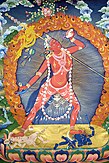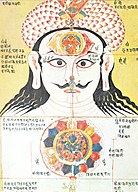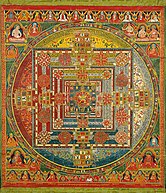
Back Tantra Afrikaans Tantra AN تنترا Arabic Tantra BCL Тантра Byelorussian Тантра Bulgarian তন্ত্র Bengali/Bangla Tantrisme Catalan Tantrismus Czech Tantra Welsh
| Part of a series on |
| Hinduism |
|---|
 |
| Part of a series on |
| Shaktism |
|---|
 |
|
|
| Part of a series on |
| Vajrayana Buddhism |
|---|
 |
Tantra (/ˈtæntrə/; Sanskrit: तन्त्र, lit. 'expansion-device, salvation-spreader; loom, weave, warp') is an esoteric yogic tradition that developed on the Indian subcontinent from the middle of the 1st millennium CE onwards in both Hinduism and Buddhism.[1]
The term tantra, in the Indian traditions, also means any systematic broadly applicable "text, theory, system, method, instrument, technique or practice".[2][3] A key feature of these traditions is the use of mantras, and thus they are commonly referred to as Mantramārga ("Path of Mantra") in Hinduism or Mantrayāna ("Mantra Vehicle") and Guhyamantra ("Secret Mantra") in Buddhism.[4][5]
In Buddhism, the Vajrayana traditions are known for tantric ideas and practices, which are based on Indian Buddhist Tantras.[6] They include Indo-Tibetan Buddhism, Chinese Esoteric Buddhism, Japanese Shingon Buddhism and Nepalese Newar Buddhism. Although Southern Esoteric Buddhism does not directly reference the tantras, its practices and ideas parallel them. In Buddhism, tantra has influenced the art and iconography of Tibetan and East Asian Buddhism, as well as historic cave temples of India and the art of Southeast Asia.[7][8][9]
Tantric Hindu and Buddhist traditions have also influenced other Eastern religious traditions such as Jainism, the Tibetan Bön tradition, Daoism, and the Japanese Shintō tradition.[10] Certain modes of non-Vedic worship such as Puja are considered tantric in their conception and rituals. Hindu temple building also generally conforms to the iconography of tantra.[note 1][11] Hindu texts describing these topics are called Tantras, Āgamas or Samhitās.[12][13]
- ^ Gray (2016), pp. 1–3.
- ^ Cite error: The named reference
Barrett2008p12was invoked but never defined (see the help page). - ^ Flood (2006), pp. 9–14.
- ^ Bisschop (2020), Chapter 1.
- ^ Kongtrul (2005), p. 74.
- ^ Flood (2006), pp. 9, 107.
- ^ Beer (2003), pp. xi–xiv.
- ^ Berkson (1986), pp. 11–12.
- ^ Fraser-Lu & Stadtner (2015), p. 59.
- ^ Gray (2016), pp. 1–2, 17–19.
- ^ Flood (2006), p. 53,73-75,79,81-3,99,132-3,177.
- ^ Padoux (2013), p. 1.
- ^ Lorenzen (2002), p. 25.
Cite error: There are <ref group=note> tags on this page, but the references will not show without a {{reflist|group=note}} template (see the help page).
© MMXXIII Rich X Search. We shall prevail. All rights reserved. Rich X Search



